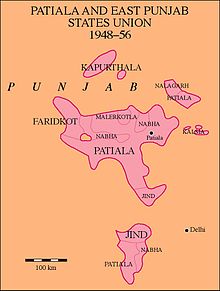Patiala and East Punjab States Union
| status | former state |
| Capital | Patiala |
| founding | July 15, 1948 |
| Dissolution / merger | November 1, 1956 ( States Reorganization Act : largely annexed to Punjab ) |
| surface | 26.208 km² |
| Residents | 3,493,685 (1951) |
| Population density | 133 people / km² |
| languages | Hindi , Punjabi |

|
|
| Location of the Patiala and East Punjab States Union in India (1951) | |
The Patiala and East Punjab States Union ( PEPSU , Panjabi ਪਟਿਆਲਾ ਅਤੇ ਪੂਰਬੀ ਪੰਜਾਬ ਸਟੇਟਸ ਯੂਨੀਅਨ ) was a state of India , which on July 15, 1948 through the merger of eight princely states of Punjab was created and in 1950 the entry into force of the Constitution of the Republic of India , a state of Indian Union was. Most of the princes were Sikhs . The capital was Patiala and the last maharaja of Patiala was Rajpramukh (head of state).
On November 1, 1956, all princely states were dissolved and PEPSU became part of the state of Punjab . The southeastern part around Jind and Narnaul came to the state of Haryana in 1966 .
The following princely states belonged to PEPSU: Patiala , Jind , Nabha , Faridkot , Kapurthala , Kalsia , Malerkotla and Nalagarh . It had an area of 26,000 km² and 3.4 million inhabitants (1948).
politics
According to the Indian constitution, PEPSU was a so-called “B-State”, ie the formal head was a former ruling prince with the title of “ Rajpramukh ”. In the case of PEPSU, this was the Maharaja of Patiala Yadavindra Singh . However, actual governance was in the hands of the chief minister, who was elected by the state's parliament. During the PEPSU's existence, parliament was elected twice, in 1951 and 1954. From 1948 to 1951, the Akali politician Gian Singh Rarewala was Chief Minister of a transitional government. After the first general election, Raghbir Singh became Chief Minister for about a year. He was then replaced by an Akali-led coalition under Gian Singh Rarewala as Chief Minister, which, however, only ruled from April 1952 to March 1953, because the state was then placed under president's rule . New elections followed, in which the Congress Party won an absolute majority of the seats. Raghbir Singh was again Chief Minister and after his death in office he was succeeded by Brish Bhan, who served until the state was dissolved and incorporated into Punjab under the States Reorganization Act 1956.
| Political party | Abbreviation | Election 1951 | Election 1954 | ||||
|---|---|---|---|---|---|---|---|
| be right | in % | Seats | be right | in % | Seats | ||
| Indian National Congress | INC | 388.185 | 28.7 | 26th | 696.979 | 43.3 | 37 |
| Akali party | AKAP | 317.502 | 23.4 | 19th | - | - | - |
| Akali (male group) | SAD (MG) | - | - | - | 334.423 | 20.8 | 10 |
| Akali (Raman group) | SAD (RG) | - | - | - | 119,301 | 7.4 | 2 |
| Bharatiya Jana Sangh | BJS | 43,809 | 3.2 | 2 | 17,505 | 1.1 | 0 |
| Communist Party of India | CPI | 64,652 | 4.8 | 2 | 97,690 | 6.1 | 4th |
| All India Scheduled Castes Federation | SCF | 47,216 | 3.5 | 1 | - | - | - |
| Kisan Mazdoor Praja Party | KMPP | 20.179 | 1.5 | 1 | - | - | - |
| Lal Communist Party | LCP | 21,539 | 1.3 | 1 | - | - | - |
| Praja Socialist Party | PSP | - | - | - | 2224 | 0.1 | 0 |
| Other parties | 54,438 | 4.0 | 0 | 0 | 0.0 | 0 | |
| Independent candidates | IND | 396,956 | 29.3 | 8th | 342,787 | 21.3 | 7th |
| total | 1,354,476 | 100.0 | 60 | 1,610,909 | 100.0 | 60 | |
In the all-India election in 1951/52 , two candidates from the Congress Party and one independent were elected in the three one-person constituencies of PEPSU, and two Akali Dal candidates were successful in the two-person constituency of Kapurthala Bhatinda .
literature
- Andreas Birken : Philatelic Atlas of British India , CD-ROM, Hamburg 2004
- Joseph E. Schwartzberg (Ed.): A historical atlas of South Asia , 2nd edition, New York / Oxford 1992, ISBN 0-19-506869-6
Individual evidence
- ↑ Roopinder Singh: Rarewala: A Punjabi-loving gentleman-aristocrat. The Tribune, December 16, 2001, accessed November 24, 2016 .
- ↑ a b Election Results - Full Statistical Reports. Indian Election Commission, accessed on November 24, 2016 (English, election results of all Indian elections to the Lok Sabha and the parliaments of the states since independence).
